I received the new 2.2KW spindle motor for my DIY CNC router today. It looks pretty nice so far. I was using a De-Walt handheld router for the spindle, but I wanted something that didn’t blow the dust and shavings all over the place.
The spindle is one of the many available on eBay in the 2.2KW range. Shipped from China it looks to be in great condition and uses ER20 collets. It was good to see that the collet nut had been drilled for balance in several places. It doesn’t look pretty but I’ll take balance over pretty any day. The motor itself is fairly heavy, I’ll probably have to use a spring or gas assist/counter-weight on the Z-axis to help support the weight. I don’t have a readily available air supply so I’m going to look at spring or gas struts that are adjustable to help support the weight.
The spindle is water cooled but I’ve done water cooled lasers and computers before so that part won’t be too difficult to setup. I ordered the VFD (Variable Frequency Drive) from another company and hopefully that will be arriving soon as well.
One of my main reasons for upgrading is that I accidentally set to high of a feed rate when cutting some aluminum and while the lights dimmed(!) the router still cut the piece with relative accuracy. I knew then that with a higher power spindle I’d be able to do some nice aluminum machining at a reasonable speed.
Here’s a picture of the spindle next to a lighter.
It’s amazing they can cram 2.2kW into such a small unit! Here’s a picture of the spindle end where you can see the drilled holes in the collet nut for balancing(of the collet nut).
Okay, I was just playing around with the lighter pic. Here’s a photo of the spindle with a real lighter somewhere in the picture.
On a side note the big lighter is almost a perfect replica of a smaller lighter, I imagine I will be focusing on much smaller projects in the future. Then I can build big, throw the lighter next to the item and make them look super tiny!
Update: The Huanyang VFD (Variable Frequency Drive) came in last week and I just got it up and running today with the 2.2kw water cooled chinese spindle. I used a 10k potentiometer / 10k pot / 10k variable resistor I had handy, which was built into a joystick from something I took apart a couple years ago. I had to fiddle with the PD settings a bit to get this to work right, and make sure that the jumper on the VFD was set to VI in order for it to respond to the commands from the potentiometer and change speed.
I also found an old water pump, a Laing DD12V-D5, that I used when I was water cooling my computer. Here’s the work list for this project.
1) Remove the DeWalt DW618 handheld router and the current SSR on/off setup I use.
2) Order and install K2 CNC mount to my Z-Axis using a spindle mount such as K2 or FineLine Automation sell.
3) Run water cooling lines and new wire for the new spindle in the cable chain. (3 wire+shield)
4) Install a 220V outlet for the VFD from the electrical box
5) Mount the VFD under the table and connect it to the Gecko 540 automation controller.
I’ll post more updates to this post specifically as things move along.
Update: I got the spindle and the VFD installed and running with Mach 3. It took a little bit of work but there’s so much help out there if you search for the common terms such as “chinese spindle mach3′ ‘chinese spindle <your controller type> ‘, etc. Every controller is a bit different, but with all the resources out there I’m sure you’ll be able to figure out a way to hook one of these up. There’s a lot of settings in the VFD controllers which need to be set right to get the speed and proper RPM readings out of the spindle but they’re all very well documented online as well.
I ended up using a 5 gallon bucket to hold the water for the spindle. My pump is not submersible so I have a hole drilled in the side of the bucket with a fitting and a line to feed the DD12V-D5 pump. I ordered some paired tubing from McMaster but the wall was too thick. I ended up going to Lowes and buying water line there from the plumbing department to get things working out alright. Take your spindle and test some hoses, you’ll find a couple of options.
The mount was a bit more work, I had put off ordering a mount because I didn’t really want to spend 80 bucks on one, and my friend Ollie told me he’d help me out if I ordered the materials. We ended up going with one he designed himself, much more basic than my design, but also more sturdy. He ran the parts on his CNC converted mill and they came out super clean. I could have run them on my machine with the DeWalt router but I doubt they could have come out as clean without a lot of sanding.
Here’s a picture of the mounts he made.
He also machined some mounting holes in my back plate for the mount and when I got home I mounted everything up. Here’s the end result.
This 2.2kW spindle runs great and I’d be willing to answer any questions about my setup or provide more pictures, just ask using the comment form below and I’ll get back to you. Here’s a shot of it cutting some FR4 1.5mm material with a 1/16th inch end mill in one pass.

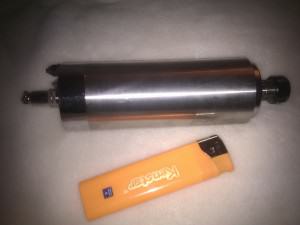
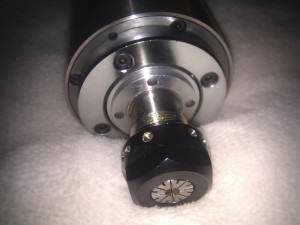
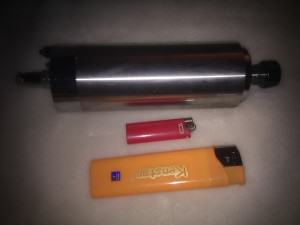
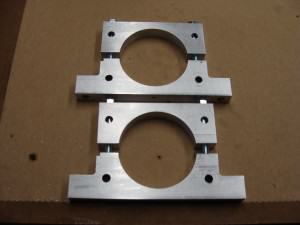
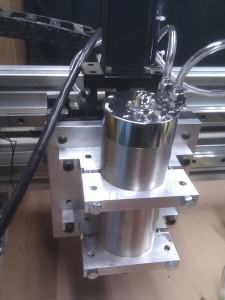

12 responses to New 2.2kw Spindle Motor for CNC Router Arrived
Hello Sir
Just purchased a 2.2kW spindle and 2.2kW VFD to upgrade my old CNC machine, Reading many accounts I understand it is a difficult process managing the installation, especially on my machine which is an old 6040Z from China with an 800W spindle. The size is only small with at present a working size of 400(X) and 550(Y) and 100?? (Z).
I am looking at using gas struts but not sure what would be required in terms of capacity load. Also looking at the required lead screw. My m/c has a 13mm Z-axis lead screw.
Hello John,
I´m wondering, is it easy for you to change tools during a machining session with this spindle? I´m interested in machining steel and aluminium with this and would like to know if this spindle is the correct one.
Hi Fomu,
It’s not too difficult to change tools during machining. You basically just need two wrenches, one for the main shaft of the spindle, and one for the collet holder and then reset your z-axis zero manually or with a sensor and automatic re-zeroing procedure. (Automatic procedure: https://www.youtube.com/watch?v=G4DeVa8rzA0 )
In regards to machining aluminum and steel, you might want to do some reading first. This spindle with a cheap VFD does not have much low speed performance. The VFD I chose won’t really run it well below 6000 RPM which can be way too high depending on the material. I’ve read a post on CNCZone.com that one guy was able to get pretty good low speed performance using a hitachi VFD and customizing the settings. Take a look at his post at http://www.cnczone.com/forums/spindles-vfd/87851-quot-chinese-quot-spindle-minimum-speed.html read the thread, but check out the post by Isakl and it may be useful.
You may also want to consider a belt driven spindle with stepped pulleys and a regular 3-phase motor driven by a VFD. This will give you a wide speed range but a heavier setup. I’ve considered adding a secondary bolt-on spindle with step pulleys on top to my Z-axis that could be run off the main spindle/motor when I needed lower speeds. When you need the low speeds you could attach the secondary spindle, flip the brushless spindle motor 180 degrees so it’s pointing to the top and add a pulley ‘tool’ into the collet to power the secondary spindle. It might be worthwhile to trying the Hitachi VFD.
Hi Jon, How is the 2.2KW spindle going? I bought one for my CNC machine that I’m building and I was surprised how heavy it is. It weighs 5KG. Is yours similar? I’m concerned that the poor ol’ Z leadscrew might have trouble lifting it. Thinking counterweights or gas struts at present. I’m building my machine out of MDF with 20mm supported shaft for the Y and 16 mm supported shaft for the X. Using 387 oz/inch steppers and a G540 too. I’m also into building model planes so hope to use it for that as well as general woodwork.
Hi Paul, I haven’t had any problems with my Z, but I lucked out on a nice ballscrew and rail arrangement that seems to have no problem with the weight. I have a friend who uses a small-diameter pneumatic cylinder connected to his air line with a regulator on it. He can dial in the amount of counter-force to balance out the spindle. You can get adjustable gas/oil filled or spring loaded cylinders (sort of like what’s in a hatchback) sold as door closers at the hardware store You can just twist the base on some of them to increase or decrease the force.
What is speed & feed use to cut aluminum with 1/8″ flush?
It depends on the type of aluminum and number of flutes you are using, check a speed an feed calculator, there are many of them out there like http://www.daycounter.com/Calculators/GCode/Feed-Rate-Calculator.phtml
Hi there,
I stumbled upon your article and am wondering just how much you paid for it.. Also i’m curious as to how the VFD is hooked up to the controller.
I would want to put one of these in a modified ShapeOko (nema17 driven DIY CNC)
Is this a wise plan you think?
Hi Ramon,
I don’t remember the exact price but it was around 550USD. I bought the spindle and vfd from two different people. It probably would have been cheaper if I bought it from one vendor.
I use a gecko 540 4 axis controller which has a variable voltage output on one of the pins which is connected to the VI pin of the VFD to control the speed. I use a relay on another output pin of the G540 to control forward and reverse/enable lines on the VFD.
As for your setup, I’m not familiar with your machine or how its linear drives are ‘geared’ and how much weight it can handle. The spindle weighs quite a bit (15-20lb?) and then you’ll have wiring and water cooling lines.
Hope that helps
How is the spindle and vfd working? Would you recommend this one, and if so, who did you buy from? Thanks!
The spindle and the VFD are working out great for me so far. I’ve done a fair amount of work in FR4 and acrylic with it so far but I’ve not done any aluminum so I can’t tell you much about that. Before I do Al I need to look up the settings to get the spindle running at much slower speed with reasonable torque. I read an article about this on CNCZone as doing it with the wrong settings can damage the VFD and motor. Right now I run between 9000 and 24000 RPM. The gentleman who provided the custom settings for the VFD said he was running speeds under 1000RPM reliably. I’d like to get it down to 1500-3000 for doing aluminum. You can of course do it at the higher RPMs but I think better quality results would be achieved being able to get the right RPM.
This looks like a great setup! Thanks for sharing a bit about it, and for posting the video.
Leave a reply to New 2.2kw Spindle Motor for CNC Router Arrived